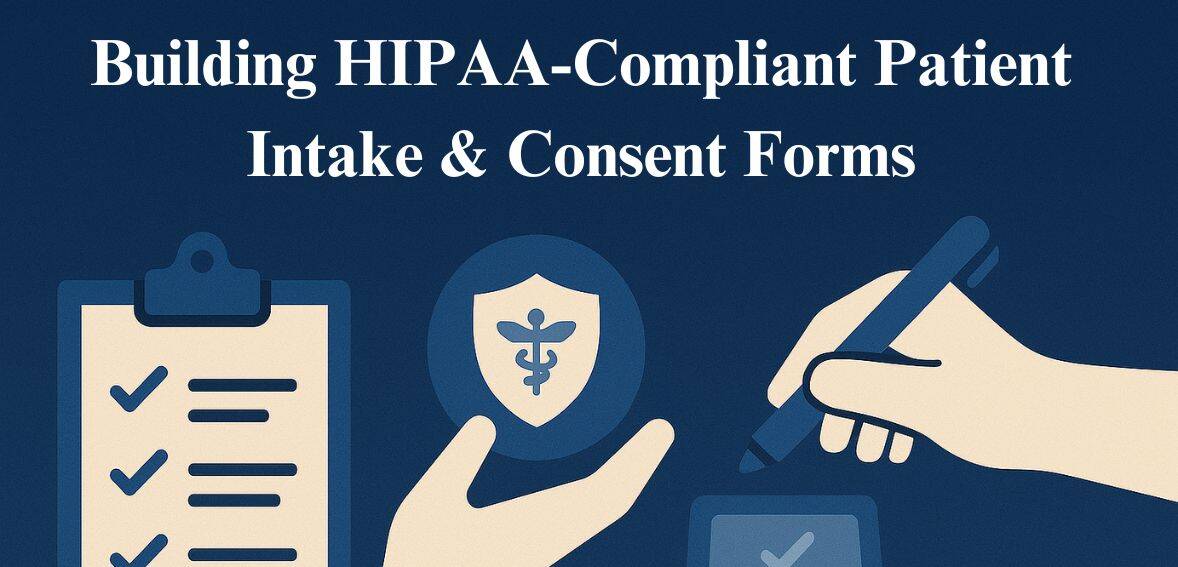
Building HIPAA-Compliant Patient Intake & Consent Forms
Patient data is a sensitive and valuable asset that needs to be protected at every touch point in the digital age of healthcare. It is more than just paperwork. Healthcare organizations are entrusted with private health information (PHI) from the very first time a patient interacts with a provider, usually through intake and consent forms. This information needs to be handled with the highest care.
Ensuring that patient intake and consent forms adhere to compliance standards is both a legal requirement and a chance to foster trust, as the Health Insurance Portability and Accountability Act (HIPAA) is the cornerstone of data privacy in the medical industry. In addition to acting as the entry point to care, these forms are essential legal documents that guarantee informed consent, safe data transfer, and regulatory compliance.
As the healthcare industry continues to embrace digital transformation, the demand for secure, user-friendly, and HIPAA-compliant form processes has never been more urgent.
Understanding the Importance of HIPAA in the Intake Process

The importance of HIPAA compliance has increased significantly as healthcare services move more and more to digital platforms. More than just a legal mandate, the Health Insurance Portability and Accountability Act (HIPAA) is a cornerstone of patient confidence and data protection. Patients give a lot of protected health information (PHI) at the point of intake, such as their insurance information, demographics, medical history, and treatment consent.
Any improper use of this data could result in major violations, fines, and a decline in confidence. In order to comply with regulations and create a safe environment where patients feel their information is valued and protected, intake and consent forms must be meticulously designed to meet HIPAA standards from the beginning.
Designing Forms That Are Both User-Friendly and Legally Compliant
When creating intake and consent forms, many healthcare providers struggle to strike a balance between user experience and compliance. In addition to ensuring that patients are aware of their rights and the intended use of their data, these forms must explicitly describe the kind of information being gathered. This includes using language that is easy to understand, straightforward, and devoid of legal terms or medical terms that could be confusing to the typical reader.
As mandated by HIPAA, forms must contain privacy notices outlining the storage and sharing of patient data. Patients should be able to easily fill out digital forms on desktops or mobile devices thanks to responsive layouts. To ensure compliance with the least amount of data collection , each entry field must be necessary and none should request information unrelated to treatment or billing.
The Role of Digital Platforms In Secure Form Collection

These days, HIPAA-compliant form builders, patient management software, and electronic health record systems are essential tools in contemporary medical practices. These platforms come with built-in compliance features like access control, secure storage, and encrypted data transfer. Secure communications between patients and healthcare providers, streamlined workflows, and real-time updates are all made possible by forms that are integrated into patient portals.
In addition to being convenient, these platforms frequently record every interaction with the form, including who filled it out, when they did so, and where they did it. This is important for audit trails and breach reporting regulations. From the first patient interaction to long-term archiving and retrieval, this digital traceability strengthens the integrity of the data lifecycle.
Integrating Patient Portals for Streamlined Compliance

One of the most effective ways to balance convenience with legal requirements is to integrate digital intake forms with HIPAA-compliant patient portals. These portals guarantee end-to-end encryption and safe authentication procedures while enabling patients to remotely submit personal and medical data.
Portals establish a well-organized ecosystem where every patient interaction is accurately recorded and preserved by centralizing all communications, document uploads, and signed forms in a single, secure location. Additionally, when paired with options like patient financing, these systems can also help reduce financial barriers, improving patient access and satisfaction.
In addition, data is transferred accurately and seamlessly when intake forms are connected to backend systems, such as electronic health records (EHRs). This lowers the possibility of clerical errors that could result in breaches and eliminates the need for manual data entry. Another benefit is that some fields can be pre-filled with previously saved information, which ensures continuity of care while saving returning patients time.
The use of integrated portals is becoming the industry standard for compliant and effective patient onboarding as more patients demand digital access.
Informed Consent as a Dynamic Legal Agreement
Informed consent is a legal recognition that a patient is fully aware of the procedure, treatment, or therapy they are consenting to; it is not a one-time checkbox. This procedure entails providing clear, culturally sensitive explanations of the treatment’s risks, options, and goals. Patients should be able to ask questions and request more information on consent forms, and there should be room for thorough explanations.
A form must demonstrate that the patient had the autonomy and chance to make an informed choice in addition to documenting the consent in order to be considered fully HIPAA-compliant. This becomes especially crucial in situations involving telehealth or remote intake, where in-person explanation is either nonexistent or very limited.
E-Signatures and Authentication in the Digital Age

Despite the widespread acceptance of electronic signatures in the healthcare industry, HIPAA requires more than just obtaining a signature. Providers are required to guarantee the authenticity, security, and traceability of the signature. Any e-signature solution used must verify the identity of the person signing the document, per HIPAA regulations.
Multi-factor authentication, IP address tracking, and secure tokens are a few examples of this. In addition, the signed document must be preserved by the system so that it cannot be changed after it has been signed. In addition to ensuring that the patient has signed, these procedures also ensure that the signed content will remain intact over time.
Access Control, Storage, and Role-Based Permissions
There is much more to HIPAA compliance than just signing a form. It goes on to discuss how that data is accessed, who can see it, and how it is stored. Role-based access controls, which restrict access to specific information to authorized personnel only, must be implemented by healthcare providers.
Employees will only have access to information pertinent to their job function thanks to this segmentation, which also reduces the possibility of internal data breaches. In order to prevent data loss in the event of a system failure or cyberattack, databases must be regularly backed up and all stored forms should be encrypted both in transit and at rest. Additionally, recording who viewed or modified the form leaves a traceable trail that is crucial for audits.
Educating Staff on Frontline Compliance Practices

The security of even the most complex digital system depends on its operators. Frontline staff training is therefore an essential component of HIPAA compliance in patient intake. Whether working at the front desk, on the phone, or through online support, staff members who handle intake forms need to receive extensive training on how to recognize and handle PHI. Training should also cover how to properly manage patient services billing, ensuring accuracy in charges and clear communication with patients about their financial responsibilities.
This requires knowing what information is deemed protected, how to gather it safely, and what procedures to adhere to in the event of a mistake or breach. When patients inquire about privacy policies and the use of their data, staff members should be able to respond with assurance. Staff members can be prepared to react appropriately in real-world scenarios through regular training sessions, refreshers, and simulated breach scenarios.
Healthcare organizations can lower risk, enhance patient communication, and show a strong commitment to safeguarding health information from the ground up by cultivating a compliance-conscious culture.
Creating Workflows for Updates, Renewals, and Version Control
Consent forms are dynamic documents, especially when it comes to long-term care or ongoing treatment programs. They frequently need to be reviewed, updated, and resigned. Always use the most recent version of the form to comply with HIPAA. Thus, healthcare institutions ought to put in place a system that notifies employees when forms are out-of-date or need to be renewed.
It may be necessary to update the consent form whenever a procedure, insurance policy, or data handling technique changes. One important aspect of compliance management systems is the capacity to archive previous iterations while preserving their accessibility for auditing purposes. Prior to resigning, patients should be informed of any changes and given a thorough explanation.
Handling Minors, Guardians, and Special Scenarios
When drafting intake and consent forms for minors or those who need a legal guardian to act on their behalf, extra care needs to be taken. The identity, legal relationship, and proof of authority of the guardian must all be entered on these forms. Because they can affect who is allowed to sign documents and under what conditions, healthcare providers should be aware of the various consent laws in different states and jurisdictions.
Furthermore, the form design may need to take into account special privacy requirements for consent for sensitive services, like mental health or reproductive care. Complying with local consent laws and HIPAA standards can be difficult, but doing so is essential to handling patient data comprehensively.
Breach Prevention and Emergency Protocols
No system is perfect. For this reason, a breach response plan is necessary for even the most secure intake and consent systems. Patients must be informed if their PHI is compromised, per HIPAA regulations. When an anomaly is detected, like unauthorized access attempts or unexpected data transfers, intake systems should be set up to promptly notify IT or compliance officers.
Employees should receive training on how to use these systems as well as what to do in the event that a breach is suspected. Procedural readiness is enhanced by preventive security, which makes sure the system is ready for both internal and external threats. Examples of preventive security include firewalls and anti-malware software.
The Long-Term Payoff of HIPAA-Compliant Form Design
Although creating intake and consent forms that comply with HIPAA may seem like a lot of work up front, the long-term advantages greatly exceed the effort. Smoother workflows, lower legal risk, and increased patient trust are all benefits of practices that use reliable, compliant systems.
By automating portions of the intake process, reducing errors and redundancies, and easing the paperwork burden, these systems can lower overhead from a business perspective. Patients will choose providers who value professionalism and privacy in both their online and offline interactions as they grow more conscious of their data rights.
Conclusion: Building Trust Through Compliance
Developing HIPAA-compliant patient intake and consent forms is a potent tactic for fostering enduring patient trust and operational effectiveness, not just an administrative necessity. The manner in which healthcare providers gather, handle, and safeguard patient data in the data-driven healthcare landscape of today says a lot about their professionalism and values.
The relationship between the patient and the provider is strengthened, loyalty is encouraged, and legal vulnerabilities are decreased when patients perceive that their information is handled with care, transparency, and security. Compliance is a commitment to providing high-quality healthcare, not just a checkbox.